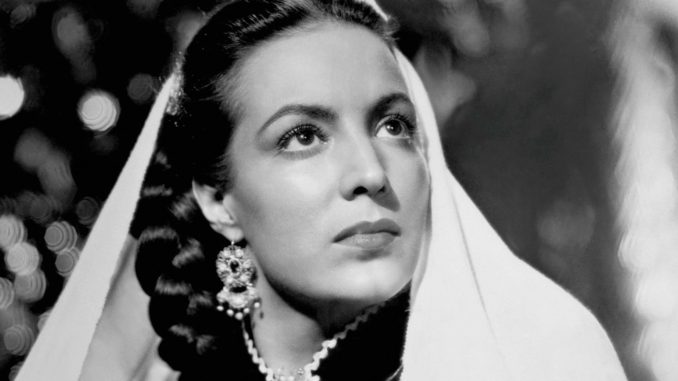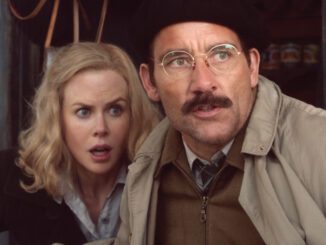
by Edward Landler
In Mexico around 1915, a day after his army has taken Cholula, the revolutionary peasant general shouts (as crudely as a stereotypical wolf-whistling construction worker) as a young woman walks by on the street, “Just to see her legs again, I’d let her slap me!”
The woman, the daughter of the city’s richest man, turns around, lifts her skirt, walks straight up to him and slaps his face, declaring, “If you’re a man, you’ll take another slap for you looked at both my legs.” Grinning, he turns his other cheek to her, and she hits him with a full straight-armed backhanded slap that knocks him off his feet.
“That’s the woman I’ll marry,” the general utters as she strides away — the first major dramatic turning point of “Enamorada” (“In Love”). It premiered in the United States 70 years ago this month, on December 2, 1949, as “The General and the Senorita” for a short run at New York City’s Playhouse Theater. The movie had originally opened in Mexico City three years earlier, on December 25, 1946, running seven weeks there in its first run.
Writer/director Emilio Fernández’s story and screenplay, written with Iñigo de Martino, was inspired by Shakespeare’s “The Taming of the Shrew” (1594) and a traditional Spanish tale first written down in Don Juan Manuel’s “The Tales of Count Lucanor” (1335) as “What happened when a man married a very strong and fierce woman.” In the film, however, the strong woman does not just obediently submit to masculine domination.
Instead, with depth and insight, “Enamorada” portrays the emergence of a real love. This love leads the general to reject his macho bravado and beg for her forgiveness, and it allows the woman to recognize her wealth and position as accidents of birth and to see the justice of the revolutionary cause. Together they will help to advance a new and more equal Mexican society.
Yet, with hardly any physical contact between them and not a single kiss, the second half of the film becomes suffused with the deep emotion and sensual desire that draws them together. For “Enamorada”, director Fernández collaborated with cinematographer Gabriel Figueroa, editor Gloria Schoemann, and stars María Félix and Pedro Armendáriz — all major figures of the 1940s’ El Cine de Oro (the Golden Age of Mexican Cinema) — to fashion a moving and classic romantic film.
In 1947, “Enamorada” won seven Silver Ariel awards, the Mexican equivalent of the Oscar, and Fernández won the Golden Ariel for his contributions to his country’s film industry. Gaining international recognition later that year, the film won awards for Best Direction and Best Cinematography at the Brussels Film Festival and was presented at the Venice Film Festival.
Its reputation rising over the years, “Enamorada” has been screened twice at the Cannes Film Festival, the first time in 2005 as part of the Cinéma de la Plaza program. In 2018, a 4K High Definition restoration by the Film Foundation’s World Cinema Project was premiered as part of Cannes Classics, introduced by Martin Scorsese.
Despite having directed about 40 movies in Mexico, filmmaker and actor Fernández is probably best known in the United States for his vivid portrayal of the brutal (and muy macho) Mexican Federal General Mapache in Sam Peckinpah’s “The Wild Bunch” (1969). Nicknamed “El Indio” for his striking features inherited from a Native American mother and mestizo (mixed race) army officer father, he went into exile to the US in 1924 at the age of 20 after taking part in a rebellion against the ruling Obregón government. For the next 10 years, he worked in the Hollywood film industry as a production assistant and extra.
According to Emilio García Riera’s 1987 biography of the filmmaker, Fernández became enthralled with cinema “as the most splendid means of expression” upon viewing fragments of Russian director Sergei Eisenstein’s footage for the unfinished “Que Viva México!” (completed posthumously in 1979) in a Hollywood cutting room in 1933. Granted amnesty in 1934 when Lázaro Cárdenas was elected president of Mexico, Fernández found work in its film industry in hopes of creating his own vision of a progressive nation with respect for its indigenous roots.
As World War II approached, the US expanded its Good Neighbor Policy in Latin America, helping Mexico enjoy an economic boom and greatly benefiting the film industry. Hollywood gave Mexican filmmakers technical support, raw materials and, occasionally, invested in their productions. The resulting hike in production made Mexico the home of the world’s leading Spanish-language movie industry.
In 1942, Fernández directed his first feature, “La Isla de la Pasión,” for a budget of only 100,000 pesos (then the equivalent of about 20,000 US dollars). In 1946, the booming economy and the success of his following films made it possible for producer Benito Alazraki Franco and Panamerican Films SA to raise over 1,500,000 pesos ($300,000) to make “Enamorada.”
While “Enamorada” was still in post production, Fernández’s “María Candelaria” (1944) became the first Mexican entry presented at Cannes, where it won the Grand Prix du Festival. This major recognition of a Mexican film justified its director’s attention to authentic themes and images to embody a national identity, and strengthened his role in furthering the industry’s Golden Age.
In Beatriz Reyes Nevares’ “The Mexican Cinema: Interviews with 13 Directors” (1976), he said:
“I understood that it was possible to create a Mexican cinema with our own actors and our own stories, without having to photograph gringos or gringas or tell stories that have nothing to do with our people.”
“Enamorada” began production in July 1946. The interiors were shot at Estudios Churubusco Azteca in Mexico City, but most of the film was shot on location in the State of Puebla in Cholula, a city renowned for its colonial architecture and its 365 churches. One of them, the Church of San Francisco Acatepec, first constructed in the 16th Century and completed in the 18th Century, serves as a setting for crucial scenes of the film. Within its sumptuous baroque interiors, cameraman Figueroa’s lensing of the characters evokes their inner shifts of attitude and emotion.
In a 50-year career with over 200 credits (including films directed by John Ford, John Huston and Luis Buñuel), Figueroa worked with Fernández on more than 20 features. The cameraman told Eugenia Meyer, for her 1976 book of interviews, “Testimonios para la historia del cinema mexicano”, “It was with Fernández that I really began to develop my own style. We spoke the same language. We thought in images.” Utilizing composition in depth, low angles, stark contrasts of light and dark, and long tracking shots inspired by muralists José Guadalupe Posada, David Alfaro Siqueiros and Diego Rivera, Figueroa also noted that the artists “said my films were murals in movement.”
In 1935, he had been mentored in Hollywood by legendary cinematographer Gregg Toland (“The Grapes of Wrath”, 1940; “Citizen Kane”, 1941), who is cited in Luis I. Reyes’ “Made in Mexico: Hollywood South of the Border” (2018) as saying, “In Mexico, there is only one cameraman stronger than I am: Gabriel Figueroa.” In 1987, he was awarded the Mexican Golden Ariel and the American Society of Cinematographers International Award in 1995.
Like Figueroa, editor Schoemann worked on more than 20 features with Fernández among her more than 200 credits, and was also honored twice for her lifetime achievement — with the Salvador Toscana Medal from the Cineteca Nacional in 1993 and the Golden Ariel in 2004.
Interviewed in historian Meyer’s “Testimonios”, she described the Mexican filmmaking process of the ‘40s: “The custom was to gather the cinematographer, the screenwriter, the director and the editor for a script reading; we would then begin to comment on the continuity and the dialogue… We would visualize what was necessary and the editor had the obligation to indicate which things didn’t add to the whole…or would slow down the film’s rhythm. ‘El Indio’ [Fernández] heard all the comments and was very accessible, a joy to work with.”
For “Enamorada”, like all the films on which they collaborated, Fernández had to write as complete and precise a shooting script as possible and Figueroa had to shoot all the necessary coverage during production. In the Mexican industry, the editor worked in the cutting room, never visited the set, and had to assemble the film with the footage given to her. Schoemann said, “Retakes and additional scenes never happened, so the editor had to figure out how to solve problems the best she could.”
Despite these apparent limitations, the editor composes a smooth and coherent continuity throughout the movie, as the story changes in tone from dynamic political drama to broad romantic comedy and, finally, to sensitive poignant romance. Contributing as well to this affective progression are the performances of Félix as Beatriz Peñafiel and Armendáriz as General José Juan Reyes.
With a natural poise and self-assurance, the beautiful Félix became a star playing an independent woman in full possession of her own body in “Doña Barbara” (1943). For “Enamorada”, her first of five films with Fernández, she was paid the highest salary in the Mexican industry to that time — 300,000 pesos ($60,000), and 6000 pesos ($1200) more for every day over schedule. The hearty and forceful Armendáriz rose to prominence in six previous Fernández films, growing into the director’s leading exemplar of Mexico’s native peoples and revolutionary ideals.
The movie’s seamless integration of acting, directing, cinematography and editing immerses the audience in the story as experienced by the characters through the entire film. Whether it is the almost slapstick one-ups-manship game between Beatriz and José Juan on either side of the locked front door of the Peñafiel household — or, later, the serenade below Beatriz’ window in a sequence built around her emotive eyes as she awakens, rises and watches José Juan and El Trio Calaveras singing in the street — viewers cannot help but be caught up in their feelings.
Curiously, on June 2, 1950, six months after “Enamorada” opened as “The General and the Senorita” in New York, an American remake called “The Torch” opened in wide release in the US. According to a May 13, 1950 article in the Los Angeles “Citizen News”, the movie’s star and associate producer, Paulette Goddard (a former wife of Charles Chaplin), saw the original movie in Mexico in 1949. The remake’s producer, Bert Granet, is quoted saying, “She thought the movie was so good that she wanted to do an English-language version and play the María Felix part.”
More curiously, the remake was shot in the same studio in Mexico City and on location in the same city of Cholula, with the same art director, the same set decorator and the same sound crew as the original — and with Figueroa as cinematographer and Fernández as director. Of the leading cast, only Armendáriz, who had made five Hollywood movies as a secondary leading man since “Enamorada”, returned to play José Juan Reyes (of the minor players, a few actors from the original were cast in different roles).
Instead of Schoemann, Charles L. Kimball, an American editor working in both Mexico and the US, cut the remake. The original’s tightly edited scenes drag clumsily in the remake. Fernández’ and Figueroa’s contributions occasionally suggest they were embarrassed to make this odd hybrid.
The screenplay, adapted by producer Granet with the original’s co-writer Iñigo de Martino, is clearly tailored to suit the American star, more than simply changing Beatriz’s name to Maria Dolores. The coquettish Goddard herself seems to confuse feminine strength with hyperactivity.
As for the movie’s first major dramatic turning point, Goddard’s Maria Dolores delivers a full straight-armed slap, fronthanded, to José Juan’s face, and Armendáriz does fall over — but it is not convincing.
Nobody can slap down a general like Félix’s Beatriz… and make him realize that “it takes a real macho to ask for forgiveness.”






